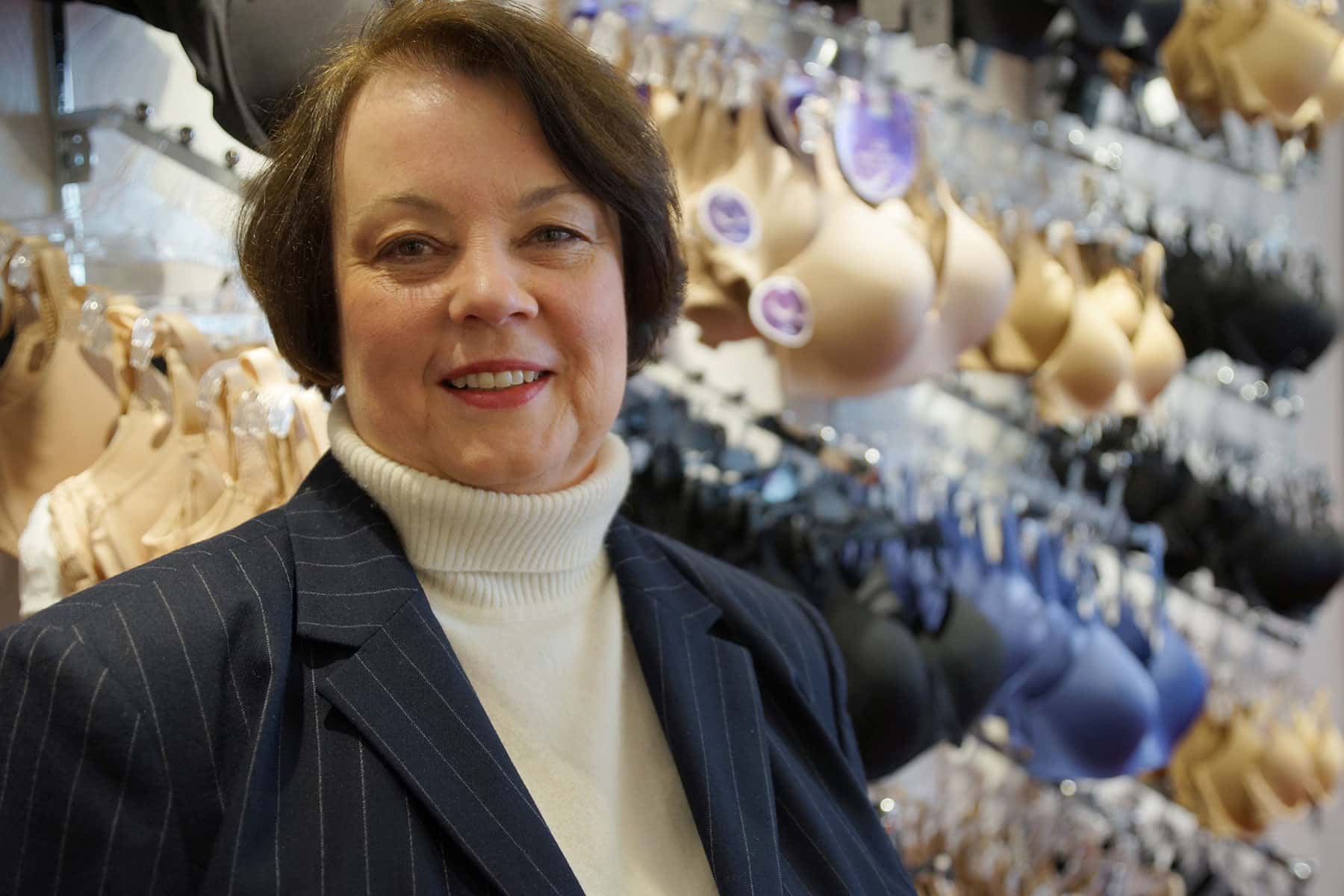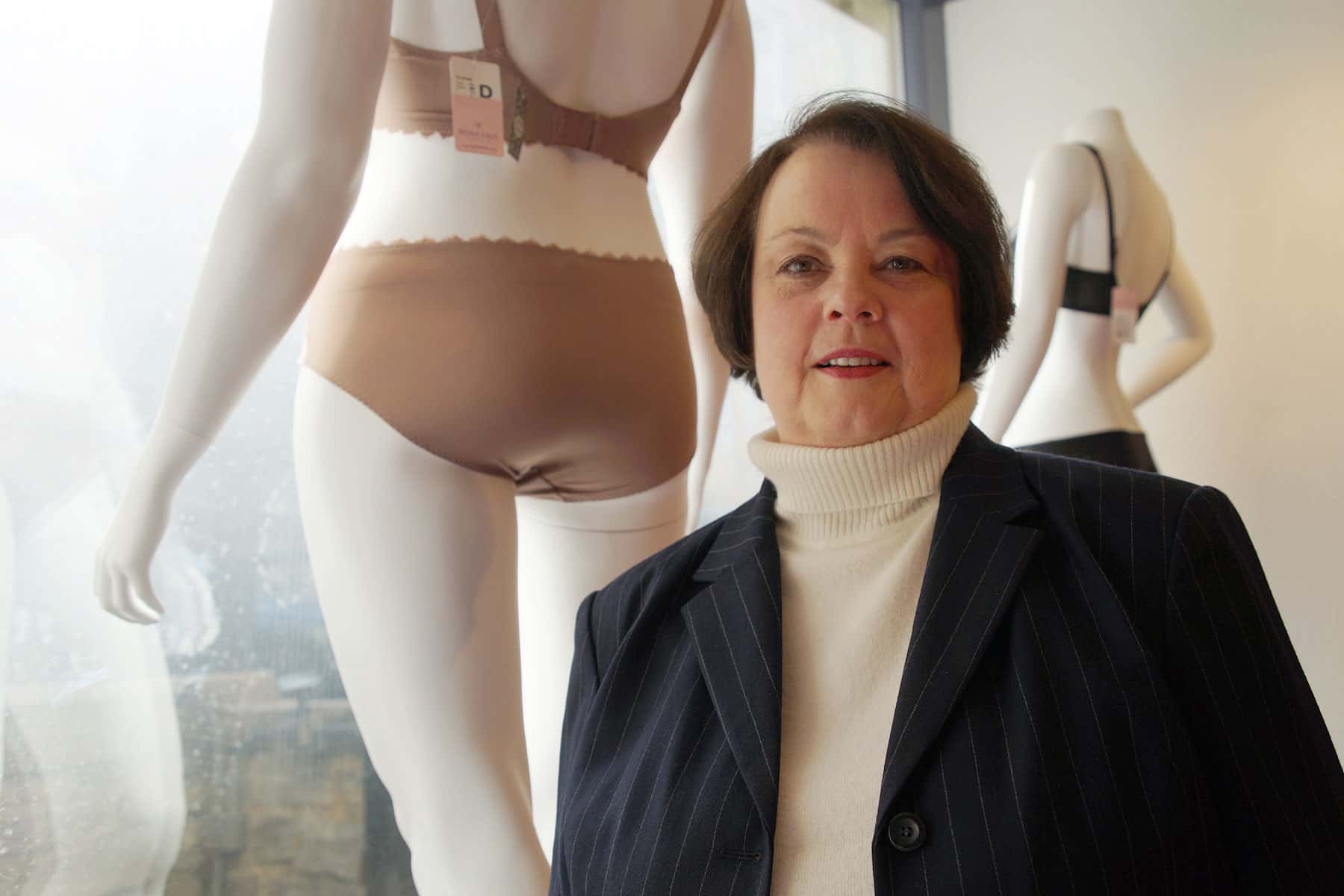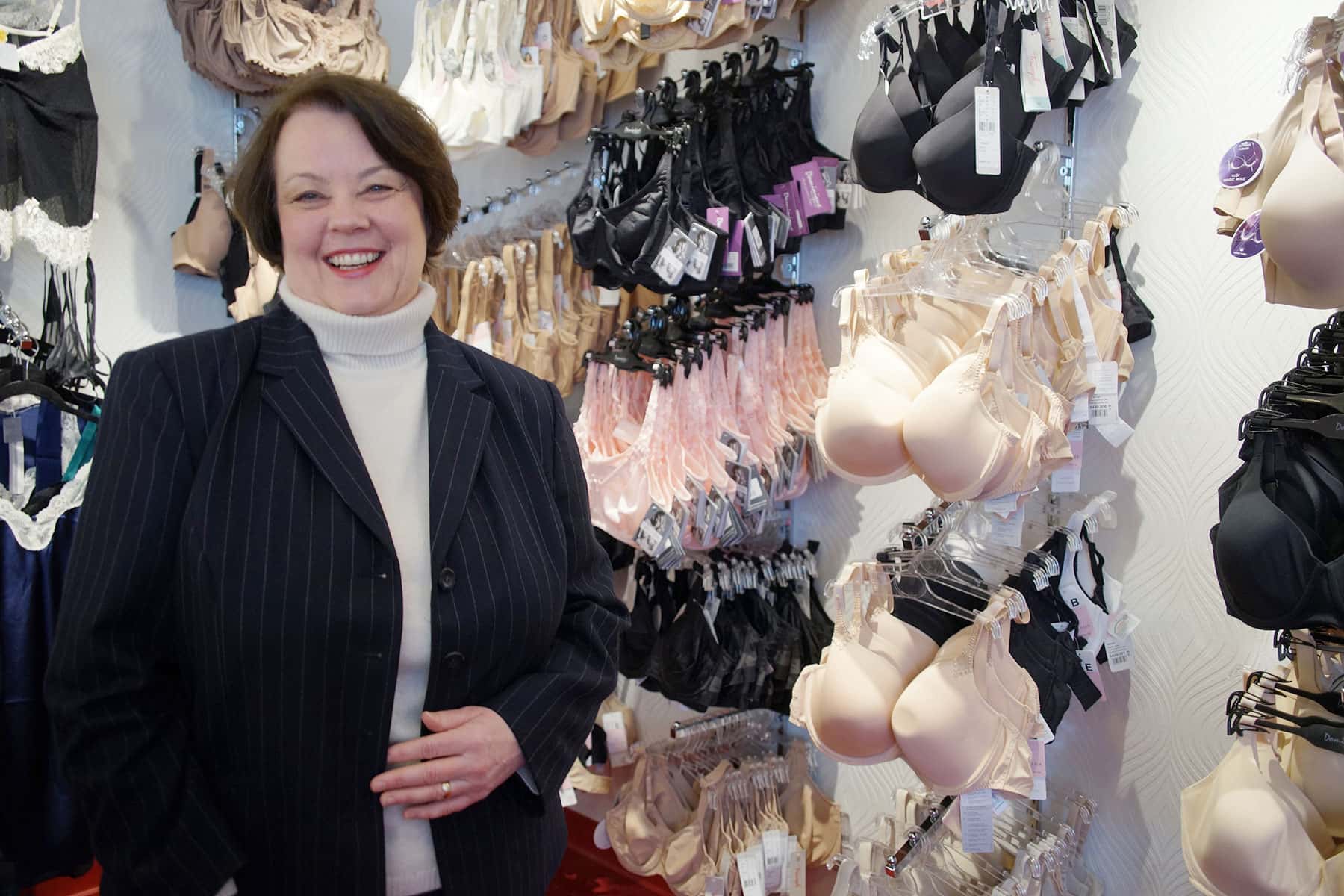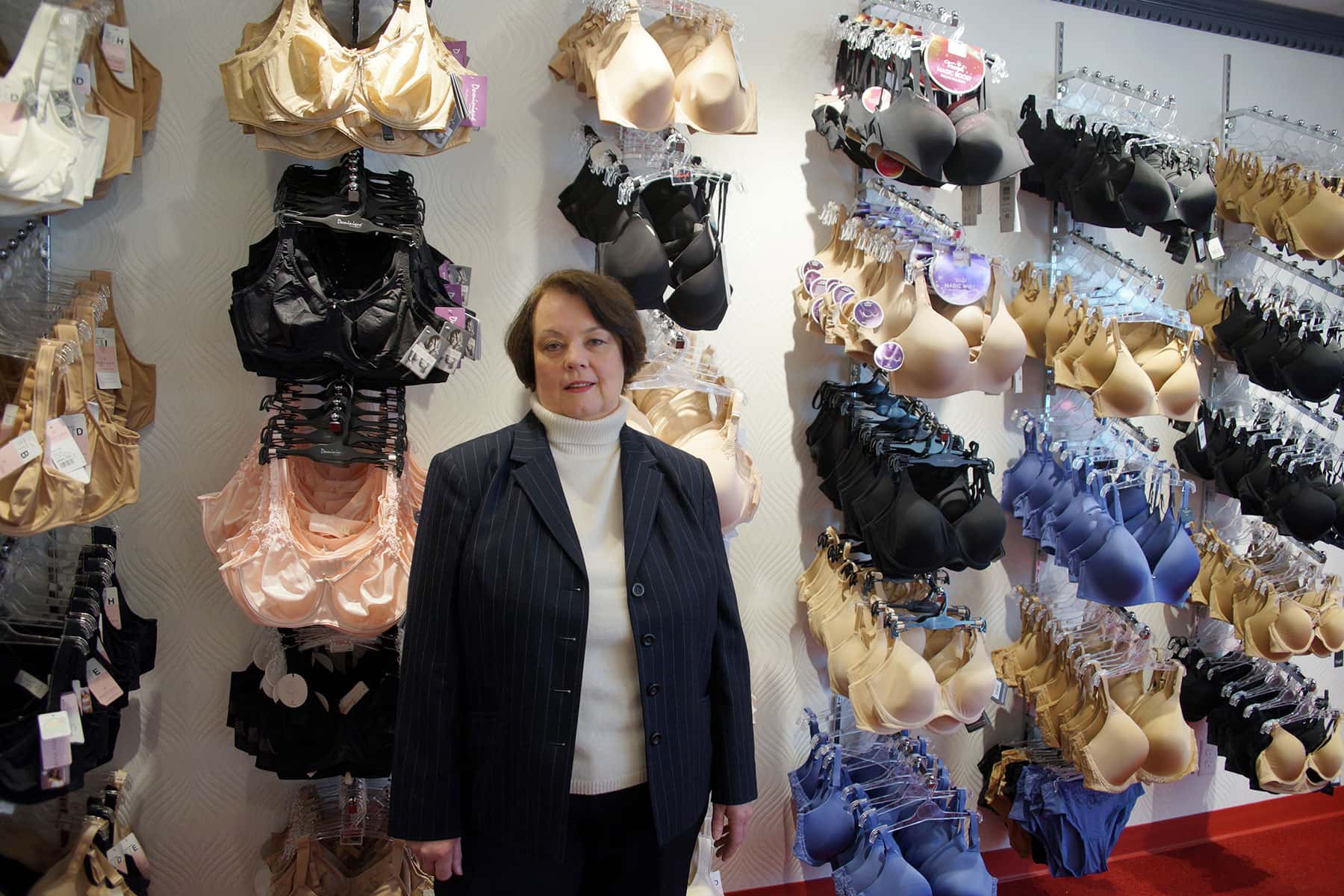
Because the sizes of clothing for women are rigged more for marketing than actual fit, Althea Meinhardt believes that women are defined by a shape instead.
After spending a career as a seamstress, performing surgery on off-the-rack apparel so it actually conforms to the female body, Meinhardt is now more of a fashion counselor than tailor as she helps women enhance their look and self-identity with undergarments.
Q&A with Althea Meinhardt
Milwaukee Independent: How did you become interested in tailoring and making alterations?
Althea Meinhardt: I started doing alterations from my dorm room at Marquette University. It started because I had friends who were MU cheerleaders, and their uniforms did not fit. Business just grew from there by word of mouth. Also, I took classes in costuming from the theater department, and learned how to make borrowed costumes fit the actors during part of our lab time in the costume shop. When I moved to Milwaukee 19 years ago, an old friend needed her daughter’s bridesmaid dress altered, and again the phone just kept ringing with referrals.
Milwaukee Independent: Did you imagine the undergarment business would become your career?
Althea Meinhardt: I NEVER imagined being a retail store owner or in the lingerie business. But I came to realize how much women in Milwaukee need my fitting expertise, and my merchandise that is chosen to fit for them. I have been told that I am like the Fairy Godmother that can make any girl look and feel beautiful. It starts with them. Then I share my tool kit of the right foundation garments and wardrobe adjustments to shape and flatter their figure, to make them look their best. So owning a lingerie store really is not a stretch from what I have been doing for many years. Having comfortable underwear that fits is as important as comfortable shoes or jeans. No matter where a woman is going, or what she is wearing, her comfort and confidence starts with the underwear she puts on in the morning. I want her to think of me every day. I want her to think about the awesome underwear that she is wearing from me, or how soon she can get in to see me for whatever she needs next.
Milwaukee Independent: What is your philosophy for working with women?
Althea Meinhardt: All women are beautiful. Clothes that fit well flatter our body and our personality. And it all starts with comfortable underwear that makes a woman look good when she is dressed. If what you are wearing feels good, it shows on your face, and affects your daily relationships with everyone you interact with.
Milwaukee Independent: What is the biggest lesson you have learned from fitting and selling to women?
Althea Meinhardt: Women are insecure about some aspect of their body, no matter her size or shape. Every woman is her own biggest critic. I try to teach women about how illusion and proportion are secret fashion weapons that they can use to get the look they want. It is about where the horizontal and vertical lines, seams or the hem on their garments, should fall on their body to be the most flattering. Also about where their bust should be positioned for the most flattering silhouette. My clients love my honesty, even when I tell them that they should return or get rid of a certain piece of clothing because it is unflattering and cannot be altered to be much better.
Milwaukee Independent: Why did you pick a downtown Milwaukee location for your store instead of the suburbs?
Althea Meinhardt: I chose a downtown location for Althea’s Fine Lingerie because there is only one place to buy bras in the city of Milwaukee that is not a discount store. Yet very few women consider the Wisconsin Avenue Boston Store to be their destination for bra shopping. Eastsiders, Downtown, and 3rd Ward dwellers will find me. They prefer not to go to the suburbs if they do not have to. Suburban shoppers expect nationally known brands and discount prices from strip mall stores. They have no problem grabbing their keys and driving to Chicago and its suburbs for boutiques and discount stores, and I can’t change those perceptions and values. I just do not feel like they are willing to embrace small privately owned retailers like me. There are very few women’s clothing boutiques left in any of our Milwaukee suburbs. Our suburban strip mall rents per square foot are comparable to suburban Chicago, but Milwaukee does not have a comparable population or income to support those retailers. I am located in a vibrant social and entertainment district. I have terrific neighbors who draw a similar client base. I am in an awesome building and have a great landlord.
Milwaukee Independent: How do you define the difference between lingerie and undergarments?
Althea Meinhardt: Lingerie is just the French word for underwear. But we Americans associate lingerie with underwear that is more than just functional underwear. For Americans, I would call any woman’s underwear that is made with lace lingerie. Underwear that does not include any lace is just underwear. But, believe it or not, lace can be an integral part of the fit and function of the garment, not just pretty embellishment. Certain kinds of lace are designed to be part of the fit to stretch, and other kinds of lace are designed into the garment for fit and stability.
Milwaukee Independent: Why do you consider women a shape and not a size?
Althea Meinhardt: Just because men or women might all measure up to fit the same size shoes or jeans, it does not mean that they will all find comfort or flattery in the same style. Their flesh, muscles, fat distribution, and bone structure will vary. Breasts also differ in shape and tissue type. Some are wide set on the rib cage, and others not. So variations in the shape of the cup dimensions, position of the straps, width of the side panels, and the differences in fabrics and elastics are some of the variables that make a bra work for one woman and not another, even if they are the same size.
Milwaukee Independent: What is your observation for how dress affects women’s self-esteem?
Althea Meinhardt: How a woman dresses does affect her self-esteem, and vice versa. In fact, I think her self-esteem affects how she chooses her wardrobe first and foremost. I have found that I can improve her self esteem when she is wearing new undergarments that fit and are functional, and when possible are a little bit more feminine than she has ever worn before. Even if there is just a little bit of lace or a new color, I have found that it can totally make a lady feel really special. And I remind her that she can wear this outfit over and over again. It will last longer than makeup or a manicure, and cost about the same.
Milwaukee Independent: What is the biggest insecurity women share with you about themselves during a fitting?
Althea Meinhardt: Usually it is the shape or size of their hips or thighs. You would think the issue is their bust being too big or too small, but that has not usually the case.
Milwaukee Independent: Perhaps an obvious question, but what are the less understood differences you have seen in the buying habits of women’s undergarments based on their age?
Althea Meinhardt: Older women are less concerned about wearing bras that have a seam on the cup, because they know that those bras provide a better profile in their clothes. Women over 40 rarely buy or wear thongs. Women over 40 typically wear more feminine sleepwear to bed than their much younger women, who frequently admit to wearing things to bed that border on rags.
Milwaukee Independent: Do you think most guys know anything about women’s undergarment, and what would you say to enlighten them?
Althea Meinhardt: They all know what they do not like. They notice when their wife or girlfriend’s underwear needs to be replaced. But they rarely will say anything. They know better. But they also seem to think that we can all just go to the mall and buy it at Victoria’s Secret. Men do not understand bra sizes. They usually get in lots of trouble if they try to buy bras for their lady, because the size is never right. They have no idea how many bras a woman tries on in the fitting room just to get one bra that fits.
Milwaukee Independent: What would surprise most men to know about lingerie?
Althea Meinhardt: I think what surprises men most about lingerie is how much it costs. Also, how many different size combinations there are, like bras, panties, and sleepwear.
Milwaukee Independent: Why do you specialize in small, family owned suppliers of your products?
Althea Meinhardt: I have chosen to use vendors that are generally small companies. Although these companies typically sell their goods in many countries, and their sales generally are in the millions of dollars per year, they are not publicly traded companies that answer to shareholders first, or command and pay for rack space in U.S. mall retailers. My success as a retailer depends on being a valued client from my vendor’s perspective. I am still very small. My business need to matter. Personal relationships with my vendors are important. I need vendors who ship right away, will handle small orders, keep inventory in stock, and will work with me on credit when possible. All of my orders are basically special orders. None of my vendors requires a particular set of styles or sizes in an order. One of my favorite vendors is from Germany, and has been owned and operated by the same family since 1868. Typically, the larger nationally known brands fail at the kind of service I need. I enjoy speaking directly to the owner or designer of my merchandise.
Milwaukee Independent: How has the self-image of women’s bodies changed due to consumer advertising in recent years?
Althea Meinhardt: I think both men and women have noticed that some consumer advertising is shifting from using only perfect people to more realistic and varied body shapes, at least incidentally. But I also think the average consumer knows that media images are still not realistic representations of our society as a whole. I have a plus size mannequin in my window. She is still smaller than the size of the average bra sale for my store and America in general. The mannequin is attracting a lot of attention from the window shoppers. I get lots of thumbs up, smiles, and nods through the window. Several women told me that she was what made them walk in to the store, because they realized that I probably had merchandise that was meant for them.
Milwaukee Independent: What can women do to break free from what some call body fascism?
Althea Meinhardt: Body fascism is discrimination based on the weight and appearance of a person. It certainly does exist. We cannot control or change the minds of others who practice this form of discrimination, but there are things that every woman can do to minimize how they are an object of those who discriminate. When a woman takes obvious measures to maximize her assets and shows that she takes the time and attention to put her best self forward with good personal grooming, clean clothes, and proper foundations for her body and outfit, everyone around her notices. But more importantly, if she does not show personal pride in this kind of self-care, that is when she becomes the object of the negative vibes that are part of body fascism. Whether we like to admit it or not, there is a greater burden on overweight women to be well appointed in order to gain social acceptance. A few centuries ago, European society celebrated and worshiped the rubenesque shaped woman as an object of beauty. These plump women were usually members of very wealthy families. That meant they did not have to work hard, and also had plenty to eat. I think in our mind’s eye we have a contemporary sense of beauty that is formed by a certain expectation of balance and proportion. Our sense of attraction and fashion is based on this subtly developed set of visuals during our own lives.
Milwaukee Independent: Do you agree that lingerie empowers women?
Althea Meinhardt: Holding a private little secret about how great you feel and look underneath your clothing can elevate your mood all day. If it makes you feel good, and has the power to make somebody else happy too, I would say that is a very empowering outfit.
Milwaukee Independent: What has been the biggest change to women’s undergarments that you have witnessed? Is it still a one size fits all industry?
Althea Meinhardt: It is the technical revolution in fabrics that all types of our underwear can be made from. I remember my mother’s bras only had elastic in a little strip, where the hooks and eyes were, in the middle of her back. The rest of the bra was an unforgiving woven cotton. Today we have underwear that can stretch in every direction, and appear to disappear from view under our clothes.
Milwaukee Independent: What caused the interest in recent years of lingerie during pregnancy?
Althea Meinhardt: About twenty years ago, shortly after my children were born, maternity fashions and attitudes toward pregnant women radically changed. That was also the emergence of Lycra stretch fabrics showing up in every clothing department. We started to see maternity clothing that clung to our baby bellies to show off a woman’s body. That was probably the beginning of maternity lingerie as a new fashion category.
Milwaukee Independent: What is your message to women who think they are defined by fashion?
Althea Meinhardt: Fashion trends do not take hold very fast or deep in Milwaukee. We maintain our comfort zone of dependable basics. Milwaukee women buy a lot of black pants. I know, because I have hemmed thousands of them over twenty years. If I was to give fashion advice to a woman of any age, it would be this: Wear what you like. Find a good tailor and dry cleaner, and visit them often.

















